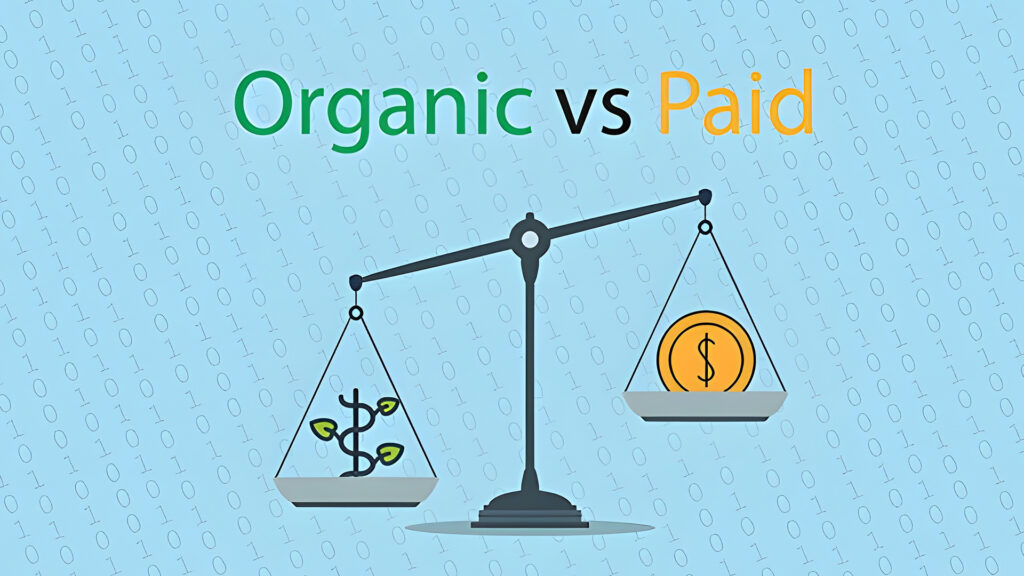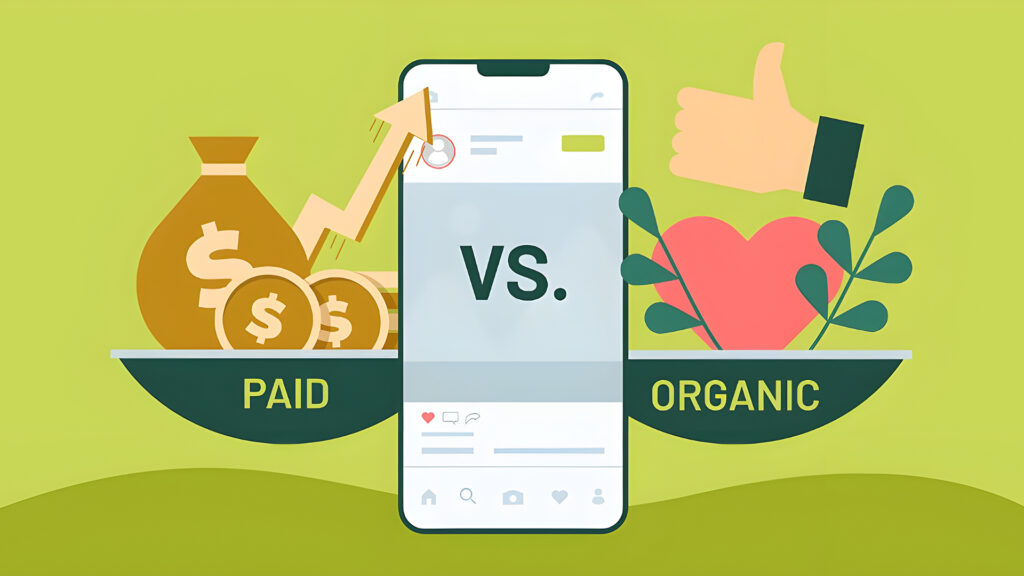Organic vs Paid Social Media: What Drives Results?

Table of Contents
Table of Contents
When businesses use social media, they choose between organic vs paid social media. Or, in other words, they ask: “Should we focus on paid vs organic social, or combine both?” This blog clearly explains what is organic social vs paid social, compares organic social media vs paid, and helps you know when to use each. Let’s dive in!
What Is Organic Social vs Paid Social?

Organic social media means posting content on platforms like Facebook, Instagram, or LinkedIn without paying for ads. It includes regular updates, photos, videos, and stories shared with followers. This type of content relies on engagement, trust, and the platform’s algorithm to reach people.
On the other hand, paid social media involves paying for ads to reach specific audiences. You can choose the demographics, interests, or behaviors of people who see your ads. It’s faster and more controllable.
So, when we talk about paid vs organic social, we’re looking at two different paths: one builds relationships slowly and authentically, while the other delivers fast and targeted reach.
Strengths & Weaknesses: Organic Social vs Paid
Both organic and paid social media have their own strengths and weaknesses. Understanding these can help you choose the right strategy for your goals.
Advantages of Organic Social Media
- It’s free to use. You don’t need to spend money on ads.
- Builds trust and loyalty. Talking with followers and replying to comments helps create a strong connection.
- Encourages user-generated content (UGC). When followers share their own posts about your brand, it feels real and spreads easily.
- Great for long-term growth. It helps build your brand’s image and trust over time.
Disadvantages of Organic Social
- It takes time. It can be slow to grow your audience without paid support.
- Has limited reach. Social media platforms control who sees your posts through algorithms.
- Less control. You can’t always choose who sees your content or when.
Advantages of Paid Social Media
- Reach more people fast. You can show your ads to people beyond your followers.
- Precise targeting. You can choose exactly who sees your ads based on age, location, interests, and more.
- Trackable results. You get data on clicks, views, and conversions to see how well your ads are doing.
- Great for quick promotions. Perfect for events, sales, or new product launches.
Disadvantages of Paid Social
- It costs money. Running ads regularly can get expensive.
- Results stop when you stop spending. Once you stop paying, the reach usually ends too.
- May feel less real. Paid ads can seem less personal and less trustworthy than organic posts.
Organic vs Paid Social: Which Should You Use?

There’s no one-size-fits-all answer when it comes to organic vs paid social media. Neither strategy is perfect on its own. The best approach is to combine both organic and paid social media for the strongest results. This creates a balanced strategy that brings long-term trust and quick results together.
When to Use Organic Social Media
Organic social is ideal for building long-term relationships with your audience. It helps you grow a community, share your brand’s story, and connect in a more personal and meaningful way.
Example: A small skincare brand might post customer reviews, skincare tips, and behind-the-scenes content to engage with followers. Over time, this builds trust and loyalty—even without spending money.
When to Use Paid Social Media
Paid social is best when you want to reach a larger or more targeted audience quickly. It’s great for short-term goals like promoting a product launch, hosting an event, or driving traffic to your website.
Example: That same skincare brand could run a paid ad campaign targeting women aged 18–35 who are interested in natural skincare. This helps them reach thousands of potential new customers in just a few days.
Tips to Make Both Work Well
To get the best results from organic vs paid social media, it’s important to know how to use each one effectively. Here are some easy tips to help you make the most of both.
Boost Your Organic Social
- Create quality content. Share posts that are interesting, helpful, or fun. Make sure they connect with your audience.
- Post regularly. Be consistent with your content and reply to comments to keep people engaged.
- Encourage user-generated content (UGC). Ask your followers to share their own posts about your brand. This builds trust and spreads your message.
- Follow trends and algorithm changes. Stay updated with what’s popular and adjust your strategy to match.
Strengthen Your Paid Social
- Use targeting tools. Choose the right audience based on age, interests, or location so your ads reach the right people.
- Track your results. Use analytics to see what’s working and where you’re getting the best return on investment (ROI).
- Set clear goals. Know what you want from your ad—more sales, more website visits, or brand awareness.
- Keep testing and improving. An ad that works today may not work tomorrow. Keep trying new ideas to stay effective.
When to Prioritize What?
Goal | Focus on Organic | Focus on Paid | Best Together |
Build brand trust | ✅ Yes | ❌ Low authenticity | ✅ Ideal |
Reach new people fast | ❌ Slow & limited reach | ✅ Fast and wide | ✅ Balanced |
Long-term results | ✅ Strong foundation | ❌ Ends with budget | ✅ Strong synergy |
Time-sensitive campaign | ❌ Might be too slow | ✅ Perfect for quick boost | ✅ Amplifies reach |
Use organic to nurture, paid to amplify, and both to achieve lasting impact.
Wrap Up!
In the debate of organic vs paid social media, the real winner is when you use paid vs organic social together. Organic builds trust, community, and long-term value. Paid delivers speed, reach, and precision. Understanding what is organic social vs paid social helps brands craft smart strategies and grow effectively.
Want help managing both organic and paid social media for your brand? Let Cubitrek handle it for you!
Common Queries
1. What are the key differences between organic and paid social media marketing?
Organic is free content that grows slowly, while paid uses ads to quickly reach more people.
2. What is the 5-5-5 rule on social media?
It means liking 5 posts and commenting on 5 posts in 5 minutes to boost engagement and reach.
3. What is the 70/30 rule for social media?
Share 70% industry news or helpful content, and 30% about your own business.

